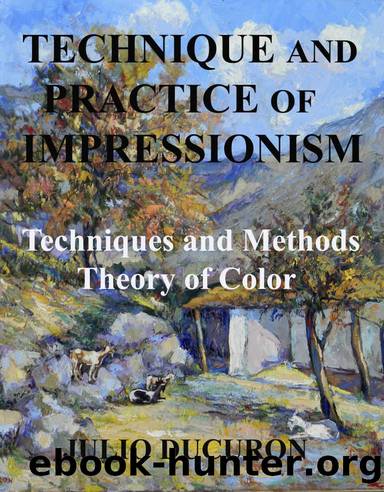Technique and Practice of Impressionism.: Techniques and Methods - Color Theory. by JULIO DUCURON

Author:JULIO DUCURON [DUCURON, JULIO]
Language: eng
Format: epub
Published: 2020-11-06T00:00:00+00:00
"Killing the white." On the support, with leftovers of Natural Siena Earth, Cadmium Green and Titanium White oils. A warm and rather dark background is achieved.
Keys
Keys are the values that appear in a conventional gray scale that touch high, middle and low sectors of the scale.
They can be with greater or less contrast, of large or small amplitude according to the needs of the values.
L
Lacquer
Lacquer is called the resinous and colored substance extracted from insects. But also lacquers are obtained from elements of nature. In the denomination of colors for oil paint we find the one called "Carminate alizarin lacquer" and is the one that is extracted from the root of the blonde, a lively plant with a square stem, thorny 1 to 2 meters long and roots thin, long and reddish.
Land line
When organizing the Contents I have placed perspective in one of the main objectives to understand, because it is easier to learn to work the line before entering the more complex parts of plans since without dimensions or perspective, they do not make sense.
When placing a figure or an object on our support to draw or paint, we must first affirm it on what is called the âLand Lineâ. It is easy to place a figure or object in any given place on the Earth Line, but it must be in correct proportion to the other figures we place. We must not forget this as it is the cause of very frequent errors where the different objects are disproportionate to each other.
Everything we draw is affected by the visual level and the point of view from which we draw it. Then we understand that the "Visual level" is the "Horizon Line" of the painting.
Level
Level is called the ordering of forms or planes in the composition. The level is determined by its location and dto the feeling of space and depth. This is called levels.
Everything that is perceived in front is called the first level or foreground; from there backwards are the different levels or planes in which the plastic work is composed.
Download
This site does not store any files on its server. We only index and link to content provided by other sites. Please contact the content providers to delete copyright contents if any and email us, we'll remove relevant links or contents immediately.
The Japanese by Christopher Harding(1084)
Watercolor With Me in the Forest by Dana Fox(751)
A Theory of Narrative Drawing by Simon Grennan(742)
The Story of the Scrolls by The Story of the Scrolls; the M(725)
Glittering Images: A Journey Through Art From Egypt to Star Wars by Camille Paglia(717)
Boris Johnson by Tom Bower(620)
This Is Modern Art by Kevin Coval(597)
The Art and Science of Drawing by Brent Eviston(588)
Frida Kahlo by Frida Kahlo & Hayden Herrera(584)
AP Art History by John B. Nici(574)
Banksy by Will Ellsworth-Jones(569)
War Paint by Woodhead Lindy(549)
Van Gogh by Gregory White Smith(547)
Draw More Furries by Jared Hodges(544)
About Looking by John Berger(543)
Scenes From a Revolution by Mark Harris(542)
Ecstasy by Eisner.;(535)
100 Greatest Country Artists by Hal Leonard Corp(523)
Young Rembrandt: A Biography by Onno Blom(512)
